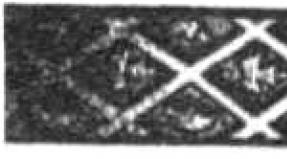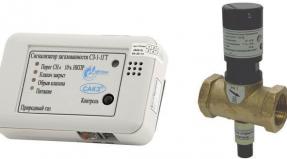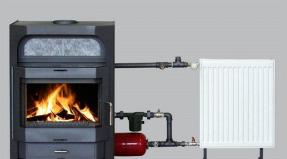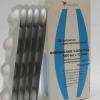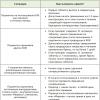Plasma cutting at home. How to make a good plasma cutter from an inverter with your own hands. Safety Precautions When Working with Plasma Cutting
The principle of operation of most plasmatrons with power from several kW to several megawatts is practically the same. An electric arc burns between a cathode made of a refractory material and an intensively cooled anode.
Through this arc, the working fluid (RT) is blown - a plasma-forming gas, which can be air, water vapor, or something else. Ionization of the RT occurs, and as a result, at the output we obtain the fourth state of aggregation of matter, called plasma.
In powerful devices, an electric magnet coil is placed along the nozzle; it serves to stabilize the plasma flow along the axis and reduce anode wear.
This article describes the second design in a row, because. the first attempt to obtain a stable plasma was not crowned with much success. Having studied the Alplaz device, we came to the conclusion that it is probably not worth repeating it one-on-one. If anyone is interested - everything is very well described in the instructions attached to it.
Our first model did not have active anode cooling. As a working fluid, water vapor from a specially constructed electric steam generator was used - a sealed boiler with two titanium plates immersed in water and connected to a 220V network.
The cathode of the plasmatron was a tungsten electrode with a diameter of 2 mm, which quickly burned out. The diameter of the anode nozzle hole was 1.2 mm, and it constantly clogged.
It was not possible to obtain a stable plasma, but there were still glimpses, and this stimulated the continuation of experiments.
In this plasma generator, a steam-water mixture and air were tested as a working fluid. The plasma output turned out to be more intense with water vapor, but for stable operation it must be overheated to a temperature of more than one hundred degrees so that it does not condense on the cooled nodes of the plasma torch.
Such a heater has not yet been made, so experiments are still ongoing only with air.
Photos of the insides of the plasma torch:

The anode is made of copper, the diameter of the nozzle opening is from 1.8 to 2 mm. The anode block is made of bronze and consists of two hermetically soldered parts, between which there is a cavity for pumping coolant - water or antifreeze.
The cathode is a slightly pointed tungsten rod with a diameter of 4 mm, obtained from a welding electrode. It is additionally cooled by the flow of the working fluid supplied under pressure from 0.5 to 1.5 atm.
And here is a completely disassembled plasmatron:

Power is supplied to the anode through the tubes of the cooling system, and to the cathode through a wire attached to its holder.
Launch, i.e. The arc is ignited by turning the cathode feed handle until it touches the anode. Then the cathode must immediately be taken to a distance of 2..4 mm from the anode (a couple of turns of the handle), and the arc continues to burn between them.
Power supply, connection of air supply hoses from the compressor and cooling system - in the following diagram:

As a ballast resistor, you can use any suitable electric heater with a power of 3 to 5 kW, for example, pick up several boilers connected in parallel.
The rectifier choke must be rated for current up to 20 A, our copy contains about a hundred turns of thick copper wire.
Diodes will fit any, designed for current from 50 A and above, and voltage from 500 V.
Be careful! This instrument uses transformerless mains power.
An automobile air compressor was taken to supply the working fluid, and an automobile glass washer is used to pump the coolant through a closed circuit. They are powered by a separate 12-volt transformer with a rectifier.
Some plans for the future
 As practice has shown, this design also turned out to be experimental. Finally got stable work within 5 - 10 minutes. But it is still far from complete perfection.
As practice has shown, this design also turned out to be experimental. Finally got stable work within 5 - 10 minutes. But it is still far from complete perfection.
Replaceable anodes gradually burn out, and it is difficult to make them from copper, and even with a thread, it would be better without a thread. The cooling system does not have direct liquid contact with a replaceable anode, and because of this, heat transfer leaves much to be desired. A direct cooling option would be more successful.
The details are machined from the semi-finished products at hand, the design as a whole is too complicated to repeat.
It is also necessary to find a powerful isolation transformer; without it, it is dangerous to use the plasma torch.
And at the end, more pictures of the plasma torch when cutting wire and steel plates. Sparks fly almost a meter :) 


In organizations whose work is related to non-ferrous types of metals, one cannot do without such a device as a plasma cutter. In domestic conditions, this tool is also often applicable, and it is not necessary to buy a ready-made tool, because you can make a plasma cutter with your own hands from an inverter.
About the work of the plasma cutter
It will be possible to make a welding fixture with high efficiency only if a person understands the welding process and the rules for operating all mechanisms. The action of the tool is based on the following:
- voltage is supplied to the plasma torch through the cables, which creates a current source;
- an arc is electrified between the cathode and anode located in the burner;
- a stream of air passes through the screwed channels under a certain pressure, which increases the temperature of the electric arc, directing it outward;
- in some cases, a liquid is used for this, which, when evaporated, forms an outlet pressure, and a high-temperature flame acts as a plasma;
- the plasma cutter enters the active phase due to the supply of mass by an electric wire, which contributes to closing the arc in the section being cut;
- during welding, argon or other inert mixtures are used.
A jet of air can raise the temperature of the arc over 7 thousand degrees, and the welder can quickly heat up the desired area of \u200b\u200bmetal in a pointwise manner.

Source of power
Homemade plasma cutter should start designing with a search for a current generator. As such, a familiar inverter can serve, the cost of which will be much less than ordinary cutting equipment. The big plus of his work is the high-frequency stable voltage, due to which the arc will burn constantly, providing a first-class cut.
The convenience of the welding inverter is also in its dimensions, which allows for on-site manipulations with a plasma cutter. Mandatory conditions for the operation of a welding plasma cutter are:

- mains supply 220 V;
- work productivity - 4 kW;
- idling - 220 V;
- with a 10-minute cycle of operation, the design mode of operation is 60%;
- width of current stabilization - from 20 to 40 A.
You can also use an AC welding transformer, but it is better to use an inverter machine with argon welding.
Features of the plasma cutter circuit
There are various drawings and video tutorials for the manufacture of welding plasma cutters. To get the right, and, most importantly, a working unit, you need the skills and ability to understand the schematic material and drawings. To convert an existing welding inverter into a homemade plasma cutter, you need to add an oscillator to the electrical circuit of the device.

The circuit works like this:

- There is a start button on the torch, by pressing it, voltage is applied to the control section.
- The relay provides air supply for cleaning the plasma torch, freeing its chamber from condensate in a couple of seconds.
- The oscillator ionizes the area between the nozzle and the electrode, causing the arc to ignite.
- A plasma torch is directed to the product and the working arc is ignited.
- The reed relay switches off the nozzle and ignition.
Do-it-yourself plasma torch assembly
To construct a plasma cutter from an inverter, you will need to purchase all related parts and prepare tools. The main components are:
- compressor;
- plasma torch;
- electrodes;
- nozzle;
- flow swirler;
- insulator;
- shutter button;
- handle with holes for cables;
- cable-hose;
- distance spring to ensure the same gap between the nozzle and the metal.









First, you need to attach a hose to the welding inverter, which is the air conductor from the compressor. The mass cable and the hose package are mounted on the front side, and the plasma torch is connected to the hose package. The burner nozzle must be attached with a clamping nut. Behind the plasma cutter is an electrode and an insulating sleeve that prevents arcing in an undesirable area.
The flow swirler directs it to the target, and the entire structure is placed in a metal or fluoroplastic housing. After assembling the welding plasma cutter, you need to check the unit for operability. When switched on, the inverter supplies high-frequency current to the plasma torch.

Applicable electrodes
Electrodes occupy a significant place in the assembly of the inverter plasma cutter. In the plasma torch, you need to select a special electrode from the appropriate material. For these purposes, parts from the following refractory substances are used:
- Beryllium.
- Zirconium.
- Thorium.
- Hafnium.



These electrodes are characterized by the ability to create a refractory oxide film during heating, which protects the instruments from damage and increases the level of protection. If you choose between these materials, then for domestic welding it is optimal to stop at hafnium and zirconium electrodes, because the other two elements produce toxic fumes.
About cable hoses and compressor

An important part of the welding plasma cutter from the inverter is the compressor, which allows the electric arc to warm up to 8 thousand degrees and is responsible for the cutting process itself. The function of the compressor also includes blowing the plasma torch and the channels of the unit, due to which debris and condensate are removed. Compressed air passing through the burner cools the working units.

For a welding plasma cutter, an ordinary compressor used during painting with a spray gun is suitable. It is connected to the equipment using a thin hose with an appropriate connector. At the inlet, you need to attach an electrovalve that is responsible for regulating the air supply. The compressor at the outlet must have a reducer to obtain a normalized pressure on the plasma torch.
The hose from the compressor to the burner and the cable from the inverter are laid in one corrugated hose, due to which the cable can be cooled during overheating, and also make work more convenient. The copper wire must have a cross section of 5–6 mm2, and the clamp at the output must guarantee safe contact with the inverter part.
A do-it-yourself plasma cutter from a welding inverter is an achievable goal. It will be faster to achieve it with the help of technical recommendations and a stock of necessary parts and tools.
Factory machine for plasma cutting. Our task: to make an analogue with our own hands
Making a functional plasma cutter with your own hands from a serial welding inverter is not so difficult as it might seem at first glance. In order to solve this problem, it is necessary to prepare all the structural elements of such a device:
- plasma cutter (it is also called a plasma torch);
- welding inverter or transformer, which will act as a source of electric current;
- a compressor, which will create an air jet necessary for the formation and cooling of the plasma flow;
- cables and hoses for combining all the structural elements of the apparatus into one system.

A plasma cutter, including a home-made one, is successfully used to perform various jobs both in production and at home. Such a device is indispensable in situations where it is necessary to perform an accurate, thin and high-quality cut of metal blanks. Separate models of plasma cutters in terms of their functionality allow them to be used as a welding machine. Such welding is carried out in an argon shielding gas environment.

When choosing a power source for completing a homemade plasma torch, it is important to pay attention to the current strength that such a source can produce. Most often, an inverter is chosen for this, providing high stability to the plasma cutting process and allowing more economical use of electricity. Differing from the welding transformer in compact dimensions and light weight, the inverter is more convenient to use. The only disadvantage of using inverter plasma cutters is the difficulty of cutting too thick workpieces with their help.

When assembling a homemade plasma cutting machine, you can use ready-made circuits that are easy to find on the Internet. On the Web, in addition, there is a video on making a plasma cutter with your own hands. Using a ready-made scheme when assembling such a device, it is very important to strictly adhere to it, and also pay special attention to the correspondence of structural elements to each other.
Plasma cutter schemes on the example of the APR-91 apparatus
When considering the circuit diagram, we will use APR-91 as a donor.
Power section diagram (click to enlarge)
Plasma cutter control scheme (click to enlarge)
Oscillator circuit (click to enlarge)
Elements of a homemade plasma cutting machine
The first thing you need to find to make a homemade plasma cutter is a power source in which an electric current with the required characteristics will be generated. Most often they are used in this capacity, which is explained by a number of their advantages. Due to its technical characteristics, such equipment provides high stability of the generated voltage, which has a positive effect on the quality of cutting. It is much more convenient to work with inverters, which is explained not only by their compact dimensions and low weight, but also by the ease of setup and operation.

Due to their compactness and low weight, inverter-based plasma cutters can be used when performing work even in the most inaccessible places, which is impossible for bulky and heavy welding transformers. A huge advantage of inverter power supplies is that they have a high efficiency. This makes them very energy efficient devices.
In some cases, a welding transformer can serve as a power source for a plasma cutter, but its use is fraught with significant power consumption. It should also be taken into account that any welding transformer is characterized by large dimensions and significant weight.
The main element of the apparatus designed for cutting metal using a plasma jet is a plasma cutter. It is this element of equipment that ensures the quality of cutting, as well as the efficiency of its implementation.

To form an air flow that will be converted into a high-temperature plasma jet, a special compressor is used in the design of the plasma cutter. The electric current from the inverter and the air flow from the compressor are fed to the plasma torch using a cable-hose package.
The central working element of a plasma cutter is a plasma torch, the design of which consists of the following elements:
- nozzles;
- a channel through which an air stream is supplied;
- electrode;
- an insulator that simultaneously performs the function of cooling.
The first thing to do before manufacturing a plasma torch is to select the appropriate electrode for it. The most common plasma cutting electrode materials are beryllium, thorium, zirconium, and hafnium. On the surface of these materials, when heated, refractory oxide films are formed, which prevent the active destruction of the electrodes.

Some of the above materials, when heated, can release compounds hazardous to human health, which must be taken into account when choosing the type of electrode. So, when using beryllium, radioactive oxides are formed, and thorium vapors, when combined with oxygen, form dangerous toxic substances. Hafnium is a completely safe material from which electrodes for a plasma torch are made.
The nozzle is responsible for the formation of the plasma jet, due to which the cutting is performed. Serious attention should be paid to its manufacture, since the quality of the workflow depends on the characteristics of this element.

The most optimal is the nozzle, the diameter of which is 30 mm. The accuracy and quality of the cut depends on the length of this element. However, the nozzle should also not be made too long, as this contributes to its destruction too quickly.
As mentioned above, the design of the plasma cutter necessarily contains a compressor that forms and supplies air flow to the nozzle. The latter is necessary not only for the formation of a jet of high-temperature plasma, but also for cooling the elements of the apparatus. The use of compressed air as a working and cooling medium, as well as an inverter that generates a working current of 200 A, makes it possible to effectively cut metal parts whose thickness does not exceed 50 mm.

In order to prepare the plasma cutting machine for operation, it is necessary to connect the plasma torch with an inverter and an air compressor. To solve this problem, a cable-hose package is used, which is used as follows.
- The cable through which the electric current will be supplied connects the inverter and the plasma cutter electrode.
- A compressed air hose connects the compressor outlet and the plasma torch, in which a plasma jet will be formed from the incoming air flow.
Features of the plasma cutter
To make a plasma cutter using an inverter for its manufacture, you need to understand how such a device works.
After the inverter is turned on, the electric current from it begins to flow to the electrode, which leads to the ignition of an electric arc. The temperature of the arc burning between the working electrode and the metal tip of the nozzle is about 6000–8000 degrees. After ignition of the arc, compressed air is supplied to the nozzle chamber, which passes strictly through an electrical discharge. The electric arc heats and ionizes the air flow passing through it. As a result, its volume increases hundreds of times, and it becomes capable of conducting electric current.
With the help of a plasma cutter nozzle, a plasma jet is already formed from a conductive air flow, the temperature of which is actively increasing and can reach up to 25-30 thousand degrees. The speed of the plasma flow, due to which the cutting of metal parts is carried out, at the exit from the nozzle is about 2–3 meters per second. At the moment when the plasma jet comes into contact with the surface of a metal part, the electric current from the electrode begins to flow through it, and the initial arc goes out. The new arc that burns between the electrode and the workpiece is called the cutting arc.
A characteristic feature of plasma cutting is that the metal being processed melts only in the place where it is affected by the plasma flow. That is why it is very important to make sure that the plasma exposure spot is strictly in the center of the working electrode. If this requirement is neglected, then the air-plasma flow may be disturbed, which means that the quality of the cut will deteriorate. In order to meet these important requirements, a special (tangential) principle of air supply to the nozzle is used.
It is also necessary to ensure that two plasma streams are not formed at once instead of one. The occurrence of such a situation, which leads to non-observance of the modes and rules for the implementation of the technological process, can provoke the failure of the inverter.
An important parameter of plasma cutting is the air flow rate, which should not be too high. The good quality of the cut and the speed of its execution is ensured by the speed of the air jet, equal to 800 m / s. In this case, the current strength coming from the inverter device should not exceed 250 A. When working in such modes, one should take into account the fact that in this case the air consumption used to form the plasma flow will increase.
It is not difficult to make a plasma cutter on your own if you study the necessary theoretical material, watch the training video and select all the necessary elements correctly. If there is such an apparatus in the home workshop, assembled on the basis of a serial inverter, not only cutting, but also plasma welding with one's own hands can be performed with high quality.
If you do not have an inverter at your disposal, you can also assemble a plasma cutter based on a welding transformer, but then you will have to put up with its large dimensions. In addition, a plasma cutter made on the basis of a transformer will not have very good mobility, since it is difficult to move it from place to place.
The work of cutting metal sheets is not so easy to do without special equipment. Therefore, all home craftsmen who are faced with a similar task should take care of having in their arsenal such a tool as a manual plasma cutting machine. This equipment is compact in size and allows you to easily cut iron sheets into suitable size fragments at home.
This tool has many advantages, the main of which is that during the separation of workpieces into segments, the owner does not have to subsequently deal with the processing of the edges of the parts. To simplify the work with this equipment, it will be useful every home craftsman get an idea about the existing varieties of these devices, their design, principle of operation and selection rules.
Equipment for plasma cutting of metal
The whole variety of such tools can be classified into two main groups:
- production;
- home purpose.
A feature of the devices representing the first group is their large size and significant weight. They are designed with CNC (computer numerical control). This fixture simplifies the production of parts of various shapes.
Working with such equipment consists in developing a layout using special software. It is on him that you will subsequently have to focus during the execution of the work. Thereafter the file created in the required format is delivered to the machine, and there it is already cut off. It is worth noting that such equipment is not cheap: the price of these units can reach tens of thousands of dollars.
 A simpler device has devices designed for plasma cutting at home. By their execution, they have type of compact block, which is powered by electricity and is supplemented with components such as a hose and a handpiece that provide an electric arc. It is thanks to her that cutting is performed.
A simpler device has devices designed for plasma cutting at home. By their execution, they have type of compact block, which is powered by electricity and is supplemented with components such as a hose and a handpiece that provide an electric arc. It is thanks to her that cutting is performed.
Also, the arc allows you to separate iron sheets and ensure high quality edges. Considering that an unusual tool in the form of a hacksaw or a disk is used to cut the workpiece, the owner does not have to spend time and effort on additional grinding of parts. Equipment for home use attractive in that it can be transported to any place, as well as stored and used for a long time.
 Models of plasma cutting devices offered on the market are designed to work with various types of materials, which is determined by the type of gas that is available in the mechanism. With the help of air-plasma type of installations, you can engage in cutting blanks from ferrous metals and their alloys. If the task arose of separating parts from non-ferrous metals and their combinations, it is advisable to use equipment that uses inactive elements such as hydrogen, nitrogen or argon. However, such a variant of gas cutting in domestic conditions is rarely resorted to.
Models of plasma cutting devices offered on the market are designed to work with various types of materials, which is determined by the type of gas that is available in the mechanism. With the help of air-plasma type of installations, you can engage in cutting blanks from ferrous metals and their alloys. If the task arose of separating parts from non-ferrous metals and their combinations, it is advisable to use equipment that uses inactive elements such as hydrogen, nitrogen or argon. However, such a variant of gas cutting in domestic conditions is rarely resorted to.
The difference between direct and indirect devices
 Today you can find various options for hand-held devices that implement a different principle of operation. The operation of direct-acting plants is based on the use of an electric arc. Last looks like a cylinder, and a jet of gas is directly connected to it. Thanks to this design, the arc is heated to high temperatures of the order of 20,000 degrees. And at the same time, it is able to effectively cool other elements of the device.
Today you can find various options for hand-held devices that implement a different principle of operation. The operation of direct-acting plants is based on the use of an electric arc. Last looks like a cylinder, and a jet of gas is directly connected to it. Thanks to this design, the arc is heated to high temperatures of the order of 20,000 degrees. And at the same time, it is able to effectively cool other elements of the device.
If we talk about installations of indirect action, then their feature is a lower efficiency. This is precisely the reason why they are not used so often.
Speaking about their device, it should be noted that the main goal here is to place the active points of the chain on the pipe either special tungsten electrode. Indirect action equipment has become widespread for spraying, heating metal devices, and they are not used as cutting equipment. For the most part, with the help of a similar manual mechanism, they repair automotive components without resorting to removing them from the body.
 At the same time, one common feature is inherent in such installations: they can only work with air filters and coolers. The benefit of the first is to increase the service life of the cathode and anode, to speed up the start of the mechanism, which has been in operation for quite a long time.
At the same time, one common feature is inherent in such installations: they can only work with air filters and coolers. The benefit of the first is to increase the service life of the cathode and anode, to speed up the start of the mechanism, which has been in operation for quite a long time.
As for the second element, it is necessary to increase the operational life of the apparatus operating in continuous mode. Optimal when for an hour of continuous cutting with this machine take about 20 minutes to rest. These characteristics are very important and must be taken into account regardless of the type of performance of the selected device.
The design of the manual plasma cutter
 The ability to perform its function for such an apparatus is ensured by the supply of highly heated air to the metal sheet. At temperatures reaching several tens of thousands of degrees, at which oxygen is heated, the latter enters the surface under high pressure, which leads to its cutting.
The ability to perform its function for such an apparatus is ensured by the supply of highly heated air to the metal sheet. At temperatures reaching several tens of thousands of degrees, at which oxygen is heated, the latter enters the surface under high pressure, which leads to its cutting.
Faster execution of this operation is provided taking into account the ionization by electric current. It is possible to extend the service life of such equipment, provided that the following elements are present in its equipment:
- Plasmatron. It has the appearance of a cutter, whose duties include performing basic tasks;
- Plasma cutter. This device can be made in the form of direct or indirect action;
- Nozzle. This device is superior in functionality to all other pieces of equipment. It makes it clear what complexity a particular model is intended to perform cutting;
- electrodes. They are equipped with certain types of devices;
- Compressor. It creates a powerful air flow.
How to make a plasma cutter from an inverter - instructions
If desired, such equipment can be made by any owner with his own hands. However, in order for a homemade plasma cutter to be able to effectively do its job, it is necessary to follow all the rules. In such a case the inverter will be almost indispensable m, since with the help of this device a reliable supply of current will be ensured. Due to it, there will be no interruptions in the operation of the plasma cutter, and it will also be possible to reduce energy consumption. However, at the same time, it also has disadvantages: it is designed for cutting material of a thinner thickness than when using a transformer.
Element selection
If you decide to make a plasma cutter yourself, then you should prepare the necessary materials and equipment:

Assembly
 Even before you start assembling a homemade plasma cutter, it does not hurt to find out if the components you purchased are compatible with each other. If you have not previously had to make a plasma cutting machine with your own hands, then it is advisable to seek help from more experienced craftsmen.
Even before you start assembling a homemade plasma cutter, it does not hurt to find out if the components you purchased are compatible with each other. If you have not previously had to make a plasma cutting machine with your own hands, then it is advisable to seek help from more experienced craftsmen.
After analyzing the power of each required element, they will give you their recommendation. Definitely worth taking care of about the availability of protective clothing. You will have to use it when the time comes to check the performance of a homemade plasma cutter. If we talk about the procedure for assembling equipment for plasma cutting, then it includes the following steps:

Regardless of whether you plan to make a plasma cutter with your own hands or purchase it in a store, you should first study all the models, get acquainted with the principles of their operation and options. An important point is the type of material that is planned to be cut with this equipment in the future. You can simplify your task of choice if you first watch a video that shows the principle of operation of a manual plasma cutting machine and the technology for working with it.
Average equipment cost
Today, there are a large number of equipment for manual cutting of metals in stores, which are offered at various prices. Moreover, the cost of these devices will be influenced by several factors:

You can avoid mistakes at the stage of choosing a tool for cutting metals, provided that you visit several stores and compare the conditions under which they are ready to sell this equipment to you. Considering various models of plasma cutters, you should immediately ask about the prices of components, which you cannot do without if you have to repair this equipment. On average, the prices of spare parts for plasma cutters, taking into account the thickness of the cut, are in the following range:
- With a thickness of not more than 30 mm - 150-300 thousand rubles;
- With a thickness of not more than 25 mm - 81-220 thousand rubles;
- With a thickness of not more than 17 mm - 45-270 thousand rubles;
- With a thickness of not more than 12 mm - 32–230 thousand rubles;
- With a thickness of not more than 10 mm - 25-20 thousand rubles;
- With a thickness of not more than 6 mm - 15-200 thousand rubles.
Conclusion
 Equipment for plasma cutting of metals is a high-tech device that can significantly simplify the work of cutting various metal products. Moreover, it is by no means necessary to purchase expensive equipment in a store; each owner can make this device on their own.
Equipment for plasma cutting of metals is a high-tech device that can significantly simplify the work of cutting various metal products. Moreover, it is by no means necessary to purchase expensive equipment in a store; each owner can make this device on their own.
To do this, it is enough to prepare all the necessary equipment and follow the assembly technology of the plasma cutter exactly. Even a self-made plasma cutter is able to provide the same quality of cutting steel parts as the equipment offered in stores.
Undoubtedly, many of us have seen a video on YouTube, where Vitaly Bogachev assembled a plasma cutter from a conventional arc welding machine
I will try to explain in simple terms without any fanaticism. Vitaly removed the secondary winding on the welding transformer and instead wound a new secondary winding with a cable of smaller cross section in order to raise the output voltage to 200V. Next, I installed a diode bridge on radiators and a choke wound on iron, similar to a larger welding transformer. Connected this case to the cutter.
For purge, I used ordinary air pumped by a compressor.
Here is the first video in which Vitaly described the design of the device
In the second video, Vitaly showed how his self-made plasma cutter works. It can be seen that the cutter cuts metal up to 8mm, but Vitaliy does not show the device itself during cutting, it’s even elementary to go into this room and show where the sleeve stretches from the cutter, this is not
Honestly, well, this idea beckoned me very much and I wanted to assemble such a device, but that's what alerted me. Why factory plasma cutting machines cost decent money, if there is nothing so complicated in them, maybe there is a catch in the video and in fact the video is for PR
Firstly, you need a 200A AC arc welding machine, or rather, such machines need steam. The first transformer will be the power one, the second transformer will be the inductor. There are three windings on the welding transformer, two primary windings 0-220-400V, as well as a secondary winding 40V. This is what I plan to do with these transformers, cut both transformers, remove the secondary winding from the first one and put the primary of the second transformer in its place, so I should get 200V on the secondary winding. Now about the throttle. I still have iron from the second transformer, as well as two secondary windings that can be put on the second core and connected in series. You should get a great inductor with a yet unknown inductance.
I looked at these welding transformers in the Yandex market and found the cheapest option at 2,376 ₽ for one. So for two, including delivery, it will be approximately 6,500R.
These are the welders
I go further, we need 4 diodes with a voltage of 600V, but 1000V is better. It is better to choose a larger current for diodes, say 150A will be just right. For this case, I will turn to AliExpress. I found a suitable diode bridge for 150A 1600V for reverse breakdown, such a good margin for reverse voltage will not be superfluous. 
The price for such a diode bridge is 770.33 rubles, here is a link to buy. You also need a radiator to cool the diode bridge, there are no better ideas than a radiator from a PC processor, you can buy such a radiator at a flea market for 100-200R. And that 1000R for the rectifier
For the operation of a plasma cutter, a compressor is needed, well, this is a settled matter, it has been assembled for a long time. The compressor is good, but the air must be clean, free of oil and moisture. So it is necessary to put a dryer in front of the cutter, which, again, is better to order from China. I liked the AF2000-02 G1 / 4 filter for 442.20 rubles. 
The dryer can withstand a pressure of 1.5 MPa, which is quite satisfactory. I also need a valve for control, I will use a valve like this, the price for it is 480R. Here's a link
 You also need 1/4" fittings to connect to each other.
You also need 1/4" fittings to connect to each other. 
Alternatively, you can order 5 pieces for 276 rubles. link here
The next component of the plasma cutter and perhaps the main one is the torch itself. Such a burner costs a lot with us, but in China they also ask for 2400R for it. 
From what the Chinese offer, this is the cheapest option. You can order one from this link. Also, to connect this sleeve, you need a fitting, the same as I showed in the article about. I couldn’t find anything sensible on the Internet, so I’ll have to order from a turner. This is another 600-800 rubles
A few more components are needed for a complete set.
Several relays to control the power transformer and valve gas.  Such relays can be ordered from China for 100 rubles.
Such relays can be ordered from China for 100 rubles.
Need a 12V power supply to power the valve and relay  Such a power supply costs 232 r in China, you can buy it at this link. Connector for the control button on the holder.
Such a power supply costs 232 r in China, you can buy it at this link. Connector for the control button on the holder. 
This button turns on the transformer, opens the valve and turns on the oscillator. From China, this costs 66 rubles, a set of mom and dad. Also, a high-voltage oscillator is needed to ignite the plasma arc without contact.  A ready-made module from China for power supply from 220V AC voltage module costs 1500 rubles, link
A ready-made module from China for power supply from 220V AC voltage module costs 1500 rubles, link
Read also...
- Maps of the Simbirsk province Old maps of the Simbirsk province by Schubert
- We clean coins at home: with soap, Coca-Cola, citric acid, electrolysis method
- Detailed map of the Oryol region with villages, cities, towns and districts Schubert's map of the Oryol province 1850
- What are the signs advised to do if you find a cross
